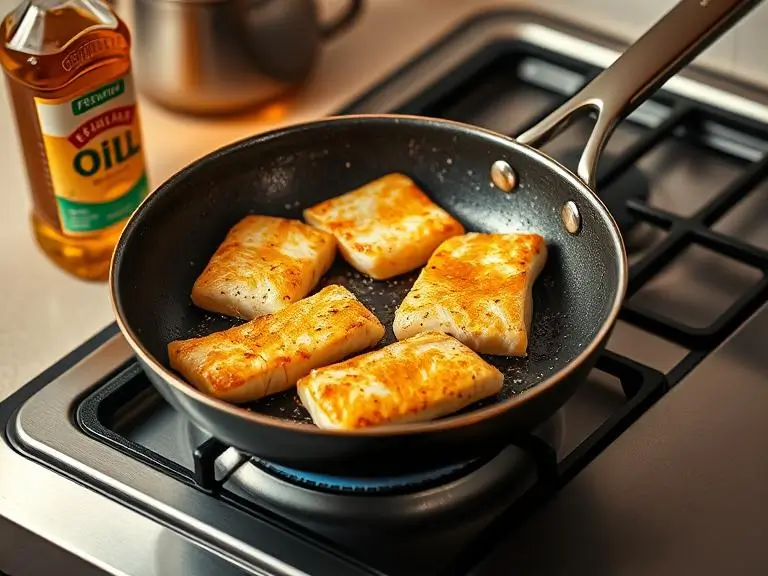best oil to fry fish: 3 Secrets for Crispy Perfection
Table of Contents
Have you ever wondered what the best oil to fry fish is? Imagine biting into perfectly crispy fish with a tender, juicy interior—a dream come true for any seafood lover.
This article explores how choosing the right oil to fry fish can transform your cooking experience and boost your recipe game.
Finding the best oil to fry fish is more than just picking any oil off the shelf. You might have tried various best oil options, only to end up with soggy or overly greasy fish. In this guide, you’ll discover three secrets for achieving crispy perfection every time you fry fish.
If you’ve struggled with uneven cooking or bland flavor, it’s time to elevate your frying technique. By understanding why the right oil matters, you’ll learn to fry fish in a way that enhances both taste and texture.
Stay with us as we reveal the insights that make all the difference when selecting the best oil to fry fish.
Why the Best Oil to Fry Fish Matters
Choosing the best oil to fry fish is essential if you want that perfect combination of crispy exterior and moist, tender interior. The oil you select not only affects the texture and flavor but also influences the overall nutritional value of your dish. When you decide on the right oil to fry fish, you’re setting the stage for a delicious and health-conscious meal.
The Science Behind Frying Fish
Understanding the science behind frying fish can help you make better choices. Here’s what happens when you fry fish in the best oil:
- Heat Transfer: The oil quickly transfers heat to the fish, creating a crispy outer layer while locking in moisture.
- Maillard Reaction: This chemical reaction between amino acids and reducing sugars gives your fried fish that desirable golden-brown color and rich flavor.
- Smoke Point Importance: Every oil has a smoke point, and choosing one with a high smoke point is critical for a successful fry.
Key takeaway: Using the best oil to fry fish not only enhances flavor but also ensures that your cooking method is both efficient and safe.
Top Factors to Consider When Choosing the Best Oil to Fry Fish
When selecting the best oil to fry fish, several factors come into play. Knowing these can help you avoid common mistakes and achieve perfect results every time.
1. Smoke Point
The smoke point is the temperature at which oil starts to burn and smoke. For frying fish, you need an oil with a high smoke point to ensure it remains stable under high heat.
- High Smoke Point Oils: Examples include peanut oil, canola oil, and sunflower oil.
- Low Smoke Point Oils: Extra virgin olive oil and butter can burn easily, leading to a bitter taste.
Expert tip: Always choose an oil with a smoke point above 400°F when planning to fry fish.
2. Flavor Profile
The flavor of the best oil to fry fish should complement rather than overpower the natural taste of the fish.
- Neutral Oils: Such as canola or sunflower oil, which let the fish’s flavor shine.
- Flavored Oils: Can add a unique twist if you’re looking for a signature taste but may mask the delicate flavors of your fish.
3. Health Considerations
Health is always a concern, especially when deep-frying.
- Unsaturated Fats: Oils rich in unsaturated fats (like olive and canola oil) are considered healthier than those high in saturated fats.
- Nutritional Balance: Look for oils that offer a balance between taste, performance, and health benefits.
4. Cost and Availability
While quality is paramount, the best oil to fry fish should also be accessible and affordable for regular cooking.
- Budget-Friendly Options: Oils like canola and peanut oil are widely available and reasonably priced.
- Premium Choices: Specialty oils may offer superior taste and performance but can be more expensive.
Step-by-Step Guide to Choosing the Best Oil to Fry Fish

Here’s a practical, step-by-step guide to help you select and use the best oil to fry fish for optimal results.
Step 1: Identify Your Cooking Method
Determine whether you’re pan-frying or deep-frying, as this influences your oil choice.
- Pan-Frying: Requires a moderate amount of oil. Opt for oils with a medium to high smoke point.
- Deep-Frying: Involves submerging the fish in oil. A high smoke point is critical here.
Step 2: Check the Smoke Point
Use the following checklist to determine if your chosen oil meets the requirements:
- Verify that the oil’s smoke point is above 400°F.
- Ensure that the oil remains stable and doesn’t break down at high temperatures.
Step 3: Consider the Flavor Impact
Reflect on how the oil’s flavor will interact with the fish.
- Neutral Flavor: Use if you want the fish’s natural taste to stand out.
- Complementary Flavor: Choose if you desire an added layer of taste.
Step 4: Evaluate Health Benefits
Review the nutritional information of your oil.
- Healthy Fats: Prefer oils with high unsaturated fat content.
- Calorie Count: Be mindful of the caloric density if health is a priority.
Summary Checklist:
- Confirm the oil’s smoke point is high.
- Assess the flavor profile.
- Check nutritional benefits.
- Consider your budget and availability.
Real-Life Examples and Expert Opinions
To further illustrate the importance of choosing the best oil to fry fish, consider these real-life examples and insights from culinary experts.
Expert Opinion: Chef Michael’s Insight
Chef Michael, renowned for his seafood specialties, explains, “When I fry fish, I always opt for an oil that offers both a high smoke point and a neutral flavor. This ensures that the fish cooks evenly and retains its natural taste. It’s all about balance.”
Research Data: Comparative Study of Frying Oils
A study conducted by the Culinary Institute of America compared various oils used for frying fish. The findings were clear:
- Oils with a high smoke point (above 400°F) consistently resulted in better texture and flavor.
- Neutral oils, such as canola, allowed the true flavor of the fish to shine without interference.
Key takeaway: These insights reaffirm that the best oil to fry fish is one that offers a high smoke point, a neutral or complementary flavor, and health benefits.
Common Mistakes to Avoid When Choosing Oil to Fry Fish
Even seasoned cooks can sometimes make mistakes when selecting the best oil to fry fish. Here are some common pitfalls and how to avoid them:
Mistake 1: Using Low Smoke Point Oils
- Problem: Oils like extra virgin olive oil may burn quickly.
- Solution: Always check the oil’s smoke point before using it for frying.
Mistake 2: Overcrowding the Pan
- Problem: Adding too many fish pieces at once can lower the oil’s temperature, leading to greasy and soggy results.
- Solution: Fry in small batches to maintain optimal temperature.
Mistake 3: Ignoring Health Considerations
- Problem: Some oils, while effective for frying, are high in saturated fats.
- Solution: Choose oils that are not only efficient but also promote healthier cooking, like canola or sunflower oil.
Mistake 4: Not Monitoring Oil Temperature
- Problem: Oil that is too hot can burn the fish, while oil that is too cool won’t crisp the exterior.
- Solution: Use a thermometer to monitor the temperature, ensuring it stays within the ideal range for frying fish.
Detailed Comparison: Table of Popular Frying Oils
Below is a table summarizing the characteristics of some popular oils used for frying fish. This comparison can help you decide on the best oil to fry fish based on your needs.
| Oil Type | Smoke Point | Flavor Profile | Health Considerations | Best Use |
|---|---|---|---|---|
| Canola Oil | 400°F – 450°F | Neutral | High in unsaturated fats | Pan-frying, Deep-frying |
| Peanut Oil | 440°F – 460°F | Mild, Nutty | Good balance of fats | Deep-frying |
| Sunflower Oil | 440°F – 450°F | Neutral | Low in saturated fats | Both frying methods |
| Vegetable Oil | 400°F | Neutral | Varies with blend | General frying |
| Extra Virgin Olive Oil | 375°F | Distinct, Fruity | Rich in antioxidants (but lower smoke point) | Light sautéing (not ideal for frying fish) |
Table Insight: As seen in the table, choosing an oil with a high smoke point and a neutral flavor is critical when aiming to fry fish perfectly.
Step-by-Step Frying Process Using the Best Oil
To help you make the most of your chosen oil, here’s a step-by-step process on how to fry fish with the best oil to fry fish.
Preparation
- Select Your Fish: Choose fresh, high-quality fish for optimal flavor.
- Dry the Fish: Pat the fish dry with paper towels to remove excess moisture.
- Season: Lightly season the fish to enhance its natural taste without overpowering the dish.
Cooking Steps
- Preheat the Oil:
- Use a deep-fry thermometer to ensure the oil reaches between 350°F to 375°F.
- If you’re pan-frying, preheat the oil in a large skillet over medium-high heat.
- Test the Oil:
- Drop a small piece of bread or batter into the oil. If it sizzles immediately and turns golden in about 30 seconds, the oil is ready.
- Fry the Fish:
- Carefully place the fish into the oil, making sure not to overcrowd the pan.
- Fry each side for 3-5 minutes, depending on thickness, until the fish is golden brown and crispy.
- Drain Excess Oil:
- Use a slotted spoon to remove the fish and place it on a paper towel-lined plate.
- Let the fish rest for a minute to drain off extra oil before serving.
Tips for Perfection
- Use a thermometer: Consistently check the oil’s temperature to avoid burning or undercooking.
- Small batches: Fry in batches to maintain the oil’s temperature and ensure even cooking.
- Flip carefully: Use a spatula to gently flip the fish for an even, crispy finish.
Real-Life Scenario: A Weekend Seafood Fry-Up
Imagine it’s a weekend, and you’re hosting a seafood dinner for your family. You decide to try out the best oil to fry fish by following these steps:
- Preparation: You choose fresh cod fillets, season them lightly, and prepare your frying station.
- Action: After preheating your canola oil to the perfect temperature, you carefully fry each fillet, ensuring they are evenly cooked.
- Result: The outcome is a plate of perfectly crispy fish that your family enjoys with a side of lemon wedges and tartar sauce.
Quote: “Using the right oil transformed my cooking. The fish came out golden and delicious every time,” shares a local chef who often hosts community cooking classes.
Expert Insights: What Professionals Recommend
Several culinary experts emphasize the importance of selecting the best oil to fry fish. Here are a few expert recommendations:
Chef Andrea’s Perspective
- Focus: “For me, the secret lies in balancing the oil’s smoke point with its flavor. I always choose an oil that can handle high heat while keeping the taste subtle so that the fish is the star.”
- Recommendation: Use a neutral oil like canola or sunflower oil for consistently excellent results.
Nutritionist’s Advice
- Health Factor: “When choosing an oil, consider its nutritional profile. Oils high in unsaturated fats not only improve the flavor but also offer health benefits such as reducing bad cholesterol.”
- Practical Tip: Incorporate oils that are both effective for frying and beneficial to your diet, ensuring that your meal is both tasty and nutritious.
Common Pitfalls and How to Avoid Them
Even when using the best oil to fry fish, there are common pitfalls you need to watch out for:
- Overheating the Oil: This can lead to a burnt taste and unhealthy compounds. Always monitor the oil temperature.
- Underestimating Oil Quantity: Not having enough oil may cause uneven cooking and stickiness.
- Ignoring Batch Sizes: Frying too many pieces at once lowers the oil temperature, resulting in soggy fish.
Quick Tips:
- Keep the oil at a consistent temperature.
- Fry in small batches.
- Always use fresh, high-quality oil for the best results.
Quick Reference Table: Best Oil to Fry Fish Comparison
Below is a summarized table that compares the best oil to fry fish based on key factors:
| Criteria | Canola Oil | Peanut Oil | Sunflower Oil |
|---|---|---|---|
| Smoke Point | 400°F – 450°F | 440°F – 460°F | 440°F – 450°F |
| Flavor Profile | Neutral | Mild, Nutty | Neutral |
| Health Benefits | High unsaturated fats | Balanced fats | Low in saturated fats |
| Cost | Affordable | Moderately priced | Affordable |
| Ideal For | Pan & deep-frying | Deep-frying | Both frying methods |
Key takeaway: Choose an oil that fits your cooking style, health needs, and budget for the ultimate frying experience.
Top 3 Premium Oils from Amazon for Perfectly Fried Fish:
| Product | Type | Smoke Point | Key Benefits |
|---|
| La Tourangelle Organic Avocado Oil | Avocado Oil | ~520°F | Cold-pressed and premium quality, this oil is celebrated for its high heat stability and mild, neutral flavor—ideal for frying fish without altering taste. |
| Spectrum High Heat Avocado Oil | Avocado Oil | ~520°F | Formulated for high-temperature cooking, this non-GMO oil ensures that your fish cooks evenly with a clean taste, making it a favorite for professional kitchens. |
| LouAna Peanut Oil | Peanut Oil | ~450°F | A classic choice for deep frying, known for its high smoke point and subtle, nutty flavor that won’t overpower the delicate taste of your fried fish. |
Why these choices?
- High Smoke Point: All options maintain stability at high frying temperatures, ensuring a crispy finish for your fish.
- Neutral Flavor: They allow the natural flavors of your fish to stand out while adding a subtle richness.
- Premium Quality: Sourced and processed to retain nutritional benefits, these oils are trusted by chefs and home cooks alike.
Conclusion
In summary, choosing the best oil to fry fish is essential for achieving that perfect, crispy exterior and tender, juicy interior. You’ve learned that factors like the oil’s smoke point, flavor profile, health benefits, and cost all play vital roles in selecting the right oil to fry fish. Remember that using a neutral best oil not only allows the fish’s natural flavors to shine but also ensures that you fry fish safely and efficiently.
Thoughts & Expert Advice:
- Prioritize High Smoke Points: Always opt for oils that can withstand high temperatures.
- Balance Flavor & Health: A neutral oil with unsaturated fats is your best bet.
- Avoid Common Mistakes: Don’t overcrowd the pan or neglect oil temperature monitoring.
Now it’s time for you to put these insights into practice. Try out these tips, experiment with different oils, and share your results. Elevate your frying game and discover how the right oil can transform your seafood experience.
Take action today by choosing your next oil to fry fish carefully. Comment below with your favorite frying tips and share your crispy fish success stories!
Key Takeaways
- High Smoke Point is Crucial: Always select an oil that can withstand high temperatures without breaking down.
- Neutral Flavor Wins: The best oil to fry fish should not overpower the natural taste of the fish.
- Health and Budget Matter: Balance your choice with health benefits and affordability.
- Step-by-Step Process Ensures Success: Following a clear frying process can make the difference between a good dish and a great one.
Action Plan
- Assess Your Needs: Determine whether you are pan-frying or deep-frying.
- Research Oils: Check for oils with high smoke points and neutral flavors.
- Follow Expert Guidelines: Use the step-by-step process and monitor oil temperature closely.
- Practice Makes Perfect: Experiment with different oils to find the one that best suits your taste and health preferences.
- Review and Improve: Continuously refine your technique based on expert advice and your own experiences.
Final Thought: With the insights shared above, you’re now equipped to choose and use the best oil to fry fish for consistently crispy, delicious results. Remember, the right oil is not just about cooking—it’s about elevating your entire culinary experience.
You’ll Love These Too:
- chicken kabob: 3 Quick and Easy Tips for Summer BBQ
- 3 Ingredient Ground Beef Recipes: Quick & Easy Meals!
- Beef Stew 3 Quick Tips for Perfect Dinner
FAQ Section:
Q1: What is the best oil to fry fish?
A: The best oil typically has a high smoke point and a neutral flavor. Canola, peanut, or sunflower oil are excellent choices for frying fish.
Q2: Can I use olive oil for frying fish?
A: While olive oil is healthy, its lower smoke point makes it less ideal for frying fish. Use it for light sautéing rather than deep-frying.
Q3: How do I know when my oil is hot enough to fry fish?
A: Use a deep-fry thermometer to ensure your oil is between 350°F to 375°F. Alternatively, drop a small piece of bread into the oil—if it sizzles and turns golden quickly, it’s ready.
Q4: What are common mistakes when choosing an oil to fry fish?
A: Common mistakes include using low smoke point oils, overcrowding the pan, and neglecting temperature control, which can lead to greasy, unevenly cooked fish.
Q5: Why is a neutral-flavored oil preferred when I fry fish?
A: A neutral-flavored oil lets the natural taste of the fish shine through, ensuring that the flavor of the best oil to fry fish enhances rather than overpowers the dish.
Did this method work for you? Tell us your results!?
There are no reviews yet. Be the first one to write one.


